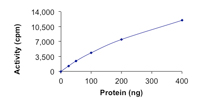
DDR1 (S496A), Active(D05-12G)
FOR BULK ORDER REQUESTS PLEASE CONTACT US
Description :Recombinant human DDR1 (S496A) (444-end) protein was expressed by baculovirus in Sf9 insect cells using an N-terminal GST tag.
Species :Human
Tag :GST tag
Expression System:Sf9 insect cells using baculovirus
Sequence :444-end (S496A)
Genbank Number :NM_001954
Specific Activity :Sample Kinase Activity Plot. For specific information on a given lot, see related technical data sheet.
Purity :Sample Purity Data. For specific information on a given lot, see related technical data sheet.
Storage, Stability and Shipping :Store product at –70oC. For optimal storage, aliquot target into smaller quantities after centrifugation and store at recommended temperature. For most favorable performance, avoid repeated handling and multiple freeze/thaw cycles.
Applications :Kinase Assay
Molecular Weight :77kDa
Gene Aliases :CAK; CD167; DDR; EDDR1 (S496A); MCK10; NEP; NTRK4; PTK3; PTK3A; RTK6; TRKE
Scientific Background :DDR1 is a member of the subfamily of tyrosine kinase receptors with a homology region to the Dictyostelium discoideum protein discoidin I in its extracellular domain. DDR1 is widely expressed in normal and transformed epithelial cells and is activated by various types of collagen. Expression of DDR1 is restricted to epithelial cells, particularly in the kidney, lung, gastrointestinal tract, and brain and DDR1 is over-expressed in fast-growing invasive tumors of the breast, ovary, esophagus, brain and lung. Collagen type I mediated stimulation of DDR1 leads to activation of matrix metalloproteinase 2 and 9 as well as increased cell invasion.
References :
1. Di Marco. et.al: Molecular cloning of trkE, a novel trk-related putative tyrosine kinase receptor isolated from normal human keratinocytes and widely expressed by normal human tissues. J. Biol. Chem. 268: 24290-24295, 1993.
2. Yoshida, D. et al: The use of 3-D culture in peptide hydrogel for analysis of discoidin domain receptor 1-collagen interaction. Cell Adh Migr. 2007 Apr;1(2):92-8.
Product Sheets (By Lot #) :
Research Areas :Apoptosis/Autophagy, Cancer, Cardiovascular Disease, NfkB Pathway, Receptor Tyrosine Kinases, Cancer, Cardiovascular Disease, NfkB Pathway, Apoptosis/Autophagy, Receptor Tyrosine Kinases
